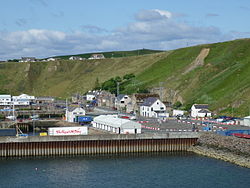Scrabster
| |
|---|---|
 Scrabster Harbour | |
Location within the Caithness area | |
| OS grid reference | ND099701 |
| Council area | |
| Lieutenancy area | |
| Country | Scotland |
| Sovereign state | United Kingdom |
| Post town | THURSO |
| Postcode district | KW14 |
| Dialling code | 01847 |
| Police | Scotland |
| Fire | Scottish |
| Ambulance | Scottish |
| UK Parliament | |
| Scottish Parliament | |
Scrabster (Scottish Gaelic : Sgrabastair/Sgrabstal) [1] is a small settlement on Thurso Bay in Caithness on the north coast of Scotland. It is some 1+1⁄2 miles (2.4 km) from Thurso, 22+1⁄2 miles (36.2 km) from Wick, 112 miles (180 km) from Inverness and 271.7 miles (437.2 km) from Edinburgh. Scrabster Harbour is an important port for the Scottish fishing industry. [2]
Contents
During the Second World War, munitions were ferried to Scapa Flow from Scrabster harbour aboard the 40 ft (12.2 m) pilot cutter Mermaid (registered in King's Lynn and built in 1908), skippered by Antony Bridges. [3]
